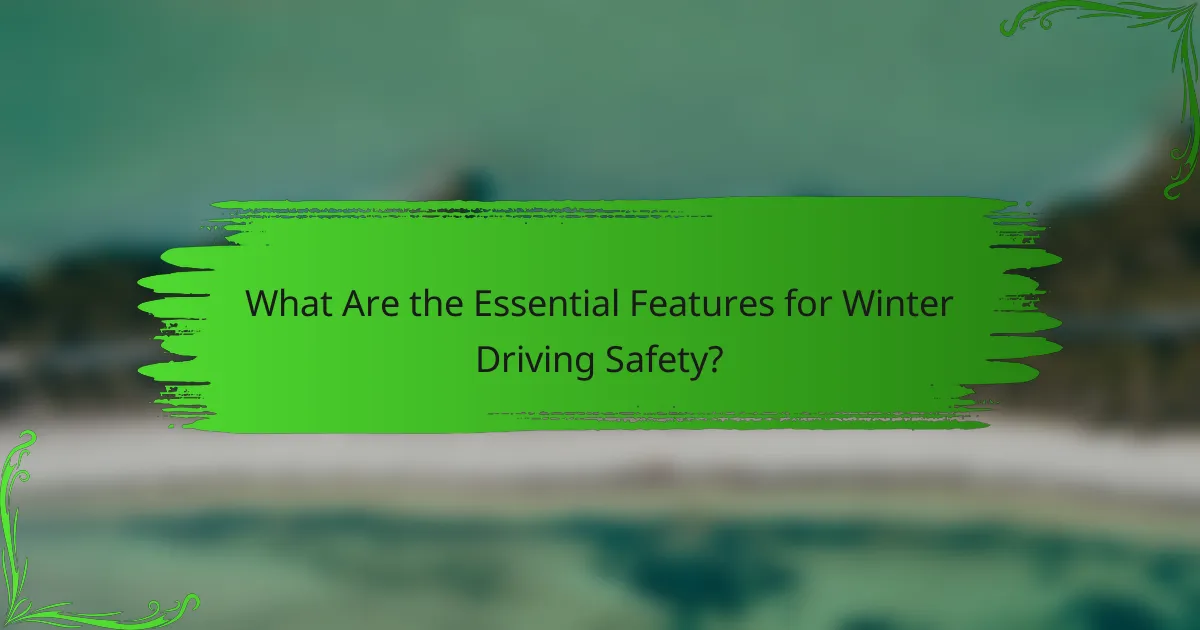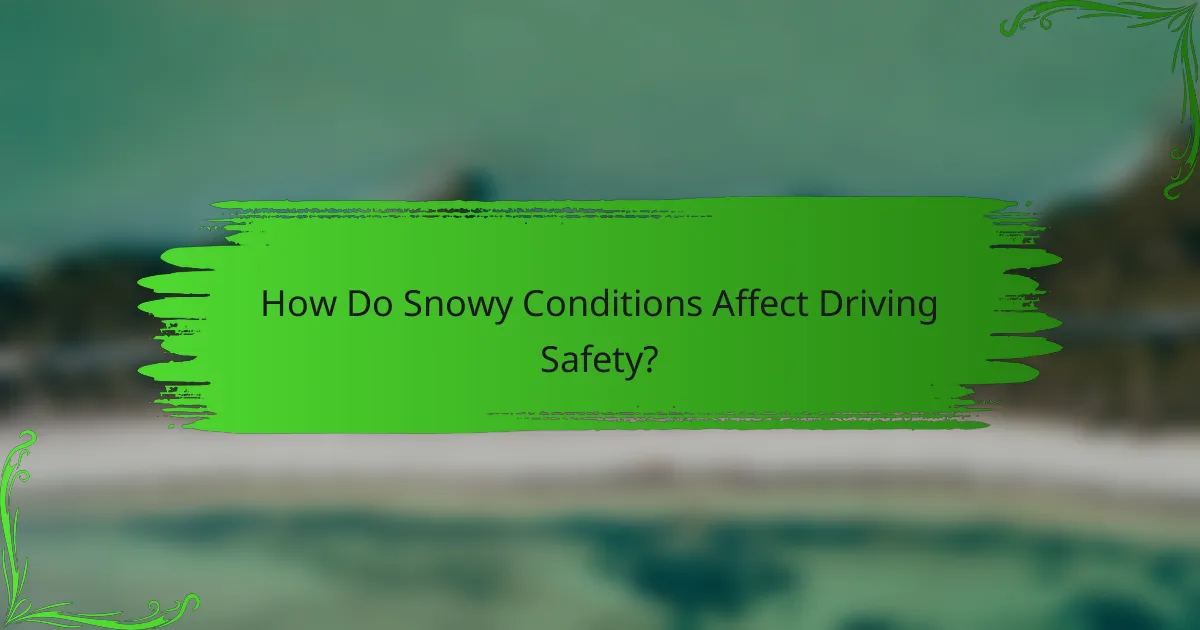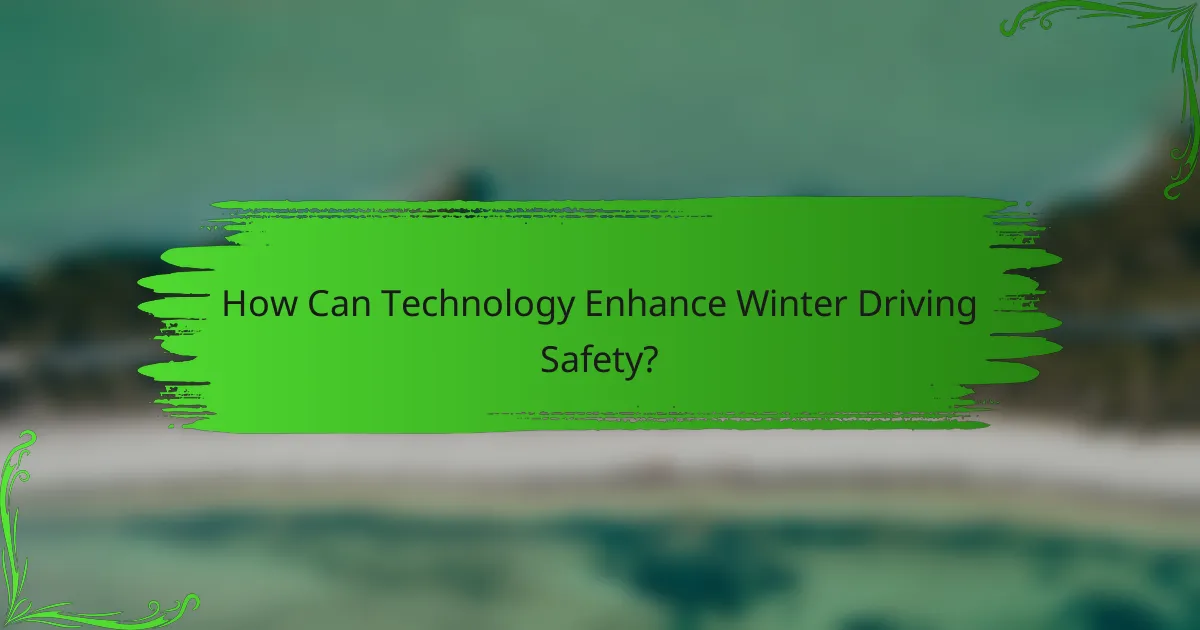Winter driving presents unique challenges due to snowy conditions that can impair visibility and increase the risk of accidents. Essential safety features such as all-wheel drive, anti-lock brakes, and winter tires are crucial for enhancing vehicle control and traction. To navigate these hazards effectively, drivers must also adopt safe driving practices, including maintaining a safe following distance and using low beams for better visibility.

What Are the Essential Features for Winter Driving Safety?
Essential features for winter driving safety include systems and equipment that enhance vehicle control and visibility in snowy conditions. Key components like all-wheel drive, anti-lock brakes, and winter tires significantly improve traction and handling, making winter travel safer.
All-Wheel Drive (AWD) Systems
All-wheel drive systems distribute power to all four wheels, enhancing traction on slippery surfaces. This feature is particularly beneficial in snowy conditions, as it helps prevent wheel spin and maintains stability during acceleration.
When considering AWD, evaluate the type of system—full-time or part-time—and its impact on fuel efficiency. Full-time AWD may provide better handling but can reduce fuel economy compared to two-wheel drive options.
Anti-lock Braking System (ABS)
An anti-lock braking system prevents the wheels from locking up during hard braking, allowing the driver to maintain steering control. This feature is crucial in winter driving, where sudden stops can lead to skidding.
Drivers should ensure their ABS is functioning properly before winter. A quick test can be performed by applying the brakes firmly; if the system is working, the driver will feel a pulsing sensation in the brake pedal.
Traction Control
Traction control systems help prevent wheel spin during acceleration by adjusting engine power or applying brakes to specific wheels. This feature is vital for maintaining grip on icy or snowy roads.
While traction control enhances safety, it is essential to understand its limits. It cannot compensate for poor tires or excessive speed on slippery surfaces, so drivers should still exercise caution.
Winter Tires
Winter tires are specifically designed to perform better in cold temperatures and snowy conditions. They feature deeper treads and softer rubber compounds that remain flexible in lower temperatures, providing improved grip.
For optimal performance, consider switching to winter tires when temperatures consistently drop below 7°C (45°F). Ensure they are properly inflated and have sufficient tread depth, ideally above 4 mm for effective snow traction.
Heated Windshields
Heated windshields use embedded heating elements to quickly defrost and de-ice the glass, improving visibility in winter conditions. This feature can save time and enhance safety by reducing the need for manual scraping.
When selecting a vehicle, check if the heated windshield option is available, as it can be a significant convenience during harsh winter months. Regular maintenance of the heating system is essential to ensure its effectiveness.

How Do Snowy Conditions Affect Driving Safety?
Snowy conditions significantly reduce driving safety by impairing visibility, increasing stopping distances, and heightening the risk of skidding. Drivers must adapt their techniques and vehicle features to navigate these hazards effectively.
Reduced Visibility
Snowfall and blowing snow can drastically limit visibility on the road, making it difficult to see other vehicles, traffic signals, and road signs. When visibility drops below 100 meters, it is crucial to slow down and use low-beam headlights to improve sightlines.
Drivers should also ensure their windshield wipers are functioning well and that their windshield is clear of snow and ice. Keeping a safe distance from other vehicles is essential, as it allows more time to react to sudden stops or obstacles.
Increased Stopping Distance
On snowy roads, stopping distances can increase significantly, often by two to ten times compared to dry conditions. This means that a vehicle traveling at 50 km/h may require over 100 meters to come to a complete stop, depending on the snow’s depth and texture.
To compensate for this, drivers should maintain a greater following distance and apply brakes gently to avoid skidding. Using anti-lock braking systems (ABS) can help maintain steering control during hard braking.
Risk of Skidding
Snow and ice create slippery surfaces that increase the likelihood of skidding, especially during sharp turns or sudden stops. Drivers should be aware that even slight acceleration can lead to loss of traction.
To minimize the risk of skidding, it is advisable to drive at lower speeds and make gradual steering and braking inputs. If skidding occurs, steering into the skid can help regain control of the vehicle.

What Are the Best Practices for Driving in Snow?
Driving in snow requires careful attention to safety practices to prevent accidents and maintain control of your vehicle. Key practices include maintaining a safe following distance, using low beams for visibility, and accelerating slowly to avoid skidding.
Maintain Safe Following Distance
In snowy conditions, it’s crucial to increase your following distance to at least six seconds behind the vehicle in front of you. This extra space allows for longer stopping distances, as braking on slippery surfaces can take significantly longer than on dry roads.
Be aware that the stopping distance can be up to ten times longer on snow compared to dry pavement. Adjust your speed accordingly, and always be prepared for sudden stops from other drivers.
Use Low Beams in Snow
Using low beam headlights is essential when driving in snow, as high beams can reflect off the snowflakes and create glare, reducing visibility. Low beams provide better illumination of the road and help you see potential hazards more clearly.
In heavy snowfall, consider using fog lights if your vehicle is equipped with them, as they can help illuminate the road directly in front of you without causing excessive glare.
Accelerate Slowly
To maintain control of your vehicle in snowy conditions, accelerate slowly and gently. Rapid acceleration can cause your tires to lose traction and lead to skidding. Instead, apply the gas gradually to allow your tires to grip the surface.
If you feel your vehicle starting to slide, ease off the accelerator and steer gently in the direction you want to go. This technique can help regain control without overreacting and worsening the situation.

Which Vehicles Are Best for Winter Conditions?
Vehicles best suited for winter conditions typically include those with features that enhance traction, stability, and control on snow and ice. Key options include SUVs with all-wheel drive (AWD), trucks equipped with snow packages, and compact cars designed with winter performance in mind.
SUVs with AWD
SUVs equipped with all-wheel drive (AWD) are among the top choices for winter driving. AWD systems automatically distribute power to all four wheels, improving traction on slippery surfaces. Popular models like the Subaru Outback and the Honda CR-V offer reliable performance in snowy conditions.
When selecting an SUV for winter, consider features such as ground clearance and winter tires. Higher ground clearance helps navigate deeper snow, while dedicated winter tires significantly enhance grip and handling.
Trucks with Snow Packages
Trucks with snow packages are designed to handle harsh winter conditions effectively. These packages often include features like enhanced traction control, skid plates, and specialized tires. Models such as the Ford F-150 and Chevrolet Silverado offer these options, making them suitable for both work and winter driving.
When choosing a truck, look for additional features like heated seats and steering wheels for added comfort during cold weather. Ensure the truck’s weight and balance support stability on icy roads.
Compact Cars with Winter Features
Compact cars with winter features can be a practical choice for urban driving in snowy conditions. Models like the Volkswagen Golf and Mazda3 often come with options for winter tires and heated elements that improve comfort and safety. These vehicles are typically more fuel-efficient and easier to maneuver in tight spaces.
When selecting a compact car for winter, prioritize those with good visibility features, such as heated mirrors and windshield wipers. Additionally, consider models with advanced safety technologies like anti-lock braking systems (ABS) to enhance control on slippery roads.

What Should You Look for When Buying Winter Driving Tech?
When purchasing winter driving technology, prioritize features that enhance safety and control in snowy conditions. Look for systems that improve traction, visibility, and overall vehicle handling to ensure a safer driving experience during winter months.
Compatibility with Vehicle Models
Ensure that the winter driving tech you choose is compatible with your vehicle model. Many systems are designed for specific makes and models, so check manufacturer specifications or consult with a dealer to avoid compatibility issues.
For example, certain traction control systems may only work with vehicles equipped with specific electronic stability controls. Always verify compatibility to maximize the effectiveness of the technology.
Ease of Use
Look for winter driving tech that is user-friendly and intuitive. Features like automatic activation, simple controls, and clear displays can make a significant difference when driving in challenging conditions.
Consider systems that provide real-time feedback on road conditions or vehicle performance. This can help you make quick decisions without becoming distracted while driving.
Cost vs. Benefits
Evaluate the cost of winter driving technology against the benefits it offers. While some systems may have a higher upfront cost, they can save you money in the long run by reducing the risk of accidents and vehicle damage.
For instance, investing in high-quality snow tires or advanced traction control systems can significantly improve your vehicle’s handling in winter conditions, potentially lowering insurance premiums and maintenance costs over time.

How Can Technology Enhance Winter Driving Safety?
Technology can significantly improve winter driving safety by providing drivers with advanced tools and features that enhance visibility, traction, and overall vehicle control. Key innovations include systems for monitoring road conditions, improving tire performance, and assisting with navigation in snowy environments.
Advanced Traction Control Systems
Advanced traction control systems help maintain grip on slippery surfaces by adjusting engine power and brake force. These systems can detect wheel slip and respond instantly, providing better stability and control when driving on ice or snow.
When considering traction control, look for vehicles equipped with all-wheel drive (AWD) or four-wheel drive (4WD) systems, as these can enhance performance in winter conditions. Regularly checking tire tread depth and ensuring proper inflation can further optimize the effectiveness of these systems.
Adaptive Headlights
Adaptive headlights improve visibility during winter driving by adjusting the direction and intensity of light based on steering angle and speed. This feature allows drivers to see around curves and better illuminate road signs or obstacles in snowy conditions.
When selecting a vehicle, consider those with LED or xenon adaptive headlights, as they often provide superior brightness and longevity. Ensure that headlights are properly aimed and free from snow buildup to maximize their effectiveness.
Winter Driving Assistance Features
Winter driving assistance features, such as lane departure warnings and automatic emergency braking, can help prevent accidents in challenging conditions. These systems use sensors to monitor the vehicle’s surroundings and alert drivers to potential hazards.
Look for vehicles that offer comprehensive safety packages, which may include features like blind-spot monitoring and rear cross-traffic alerts. Familiarize yourself with how these systems work and ensure they are activated before driving in snowy weather.
Navigation and Weather Apps
Navigation and weather apps provide real-time updates on road conditions, traffic, and weather forecasts, enabling drivers to make informed decisions. These tools can help identify the safest routes and avoid hazardous areas during winter storms.
Utilize apps that offer offline maps and weather alerts to stay informed even in areas with poor connectivity. Regularly check for updates to ensure you have the latest information before heading out in winter weather.
